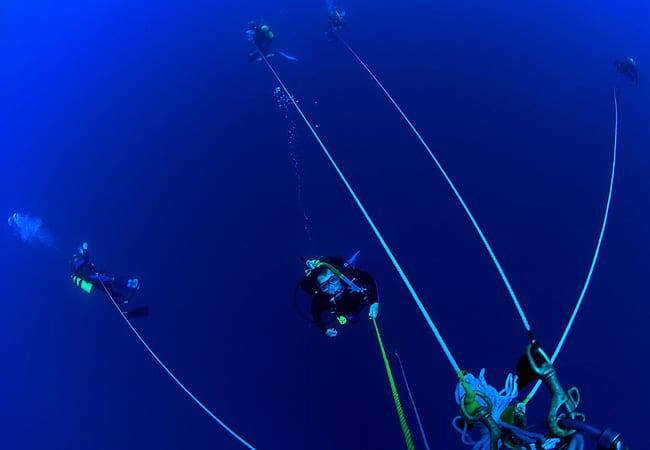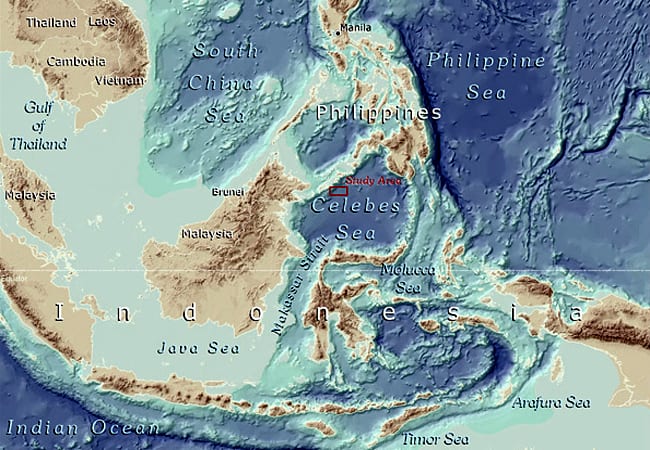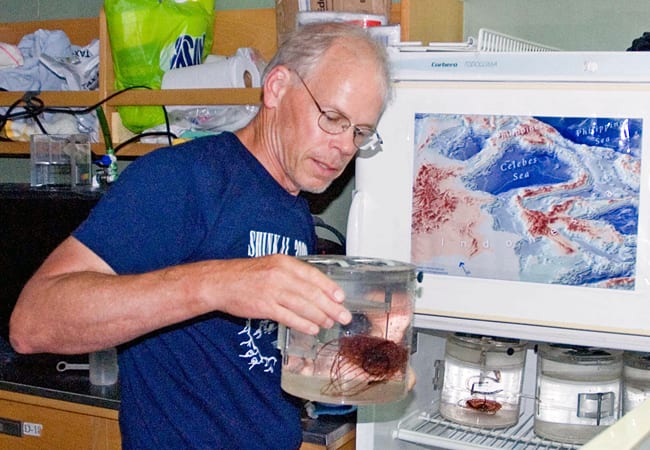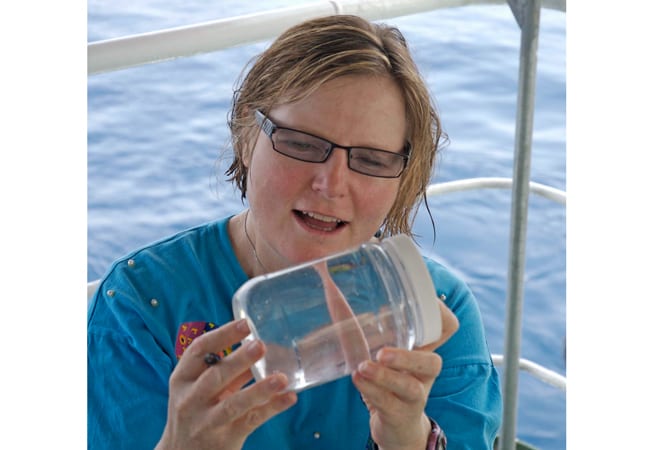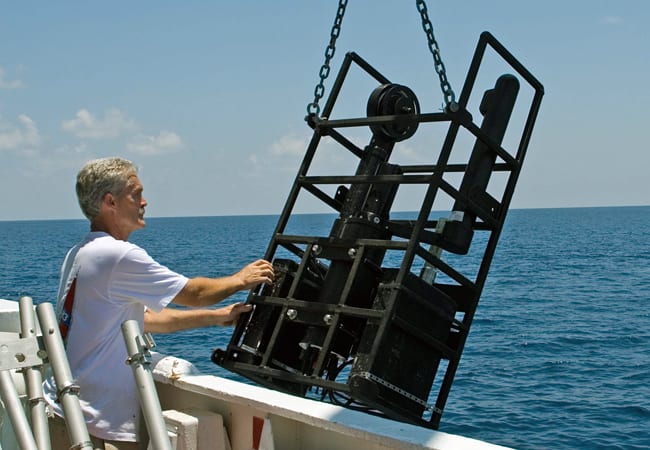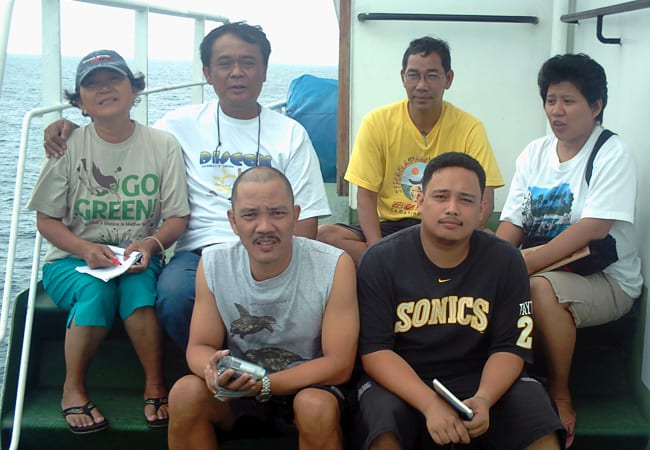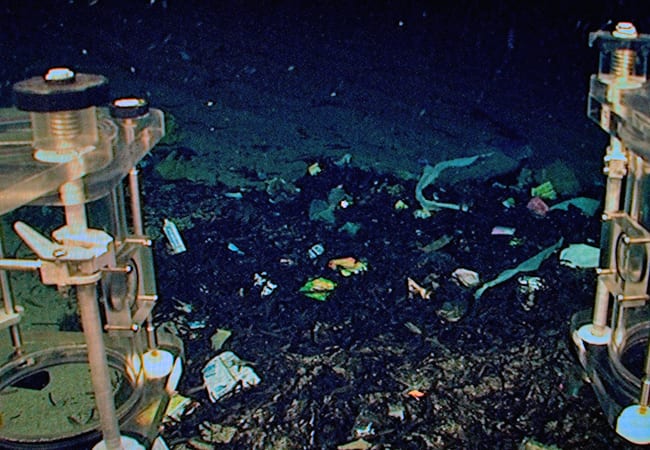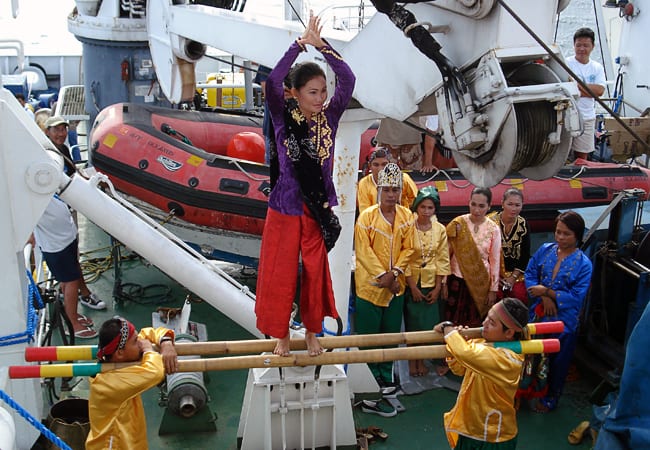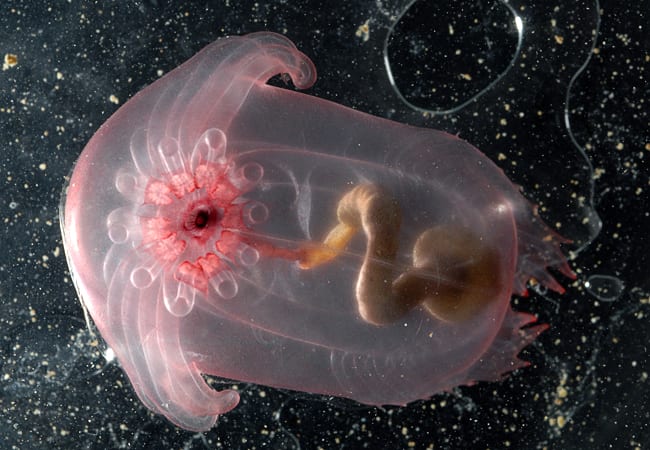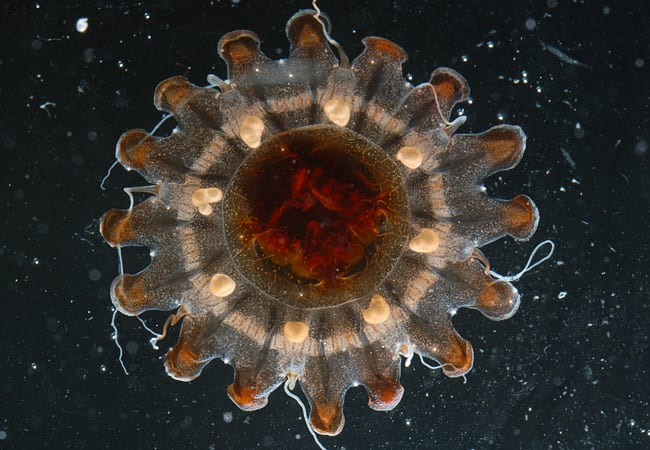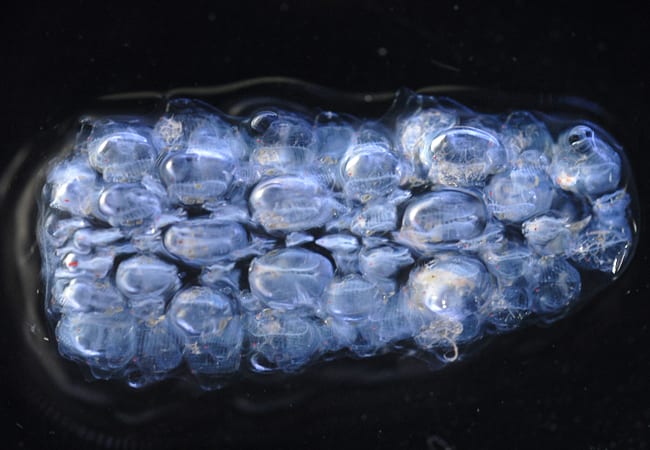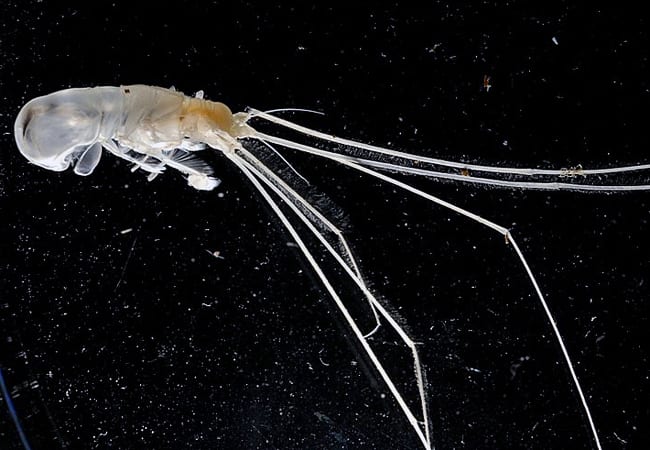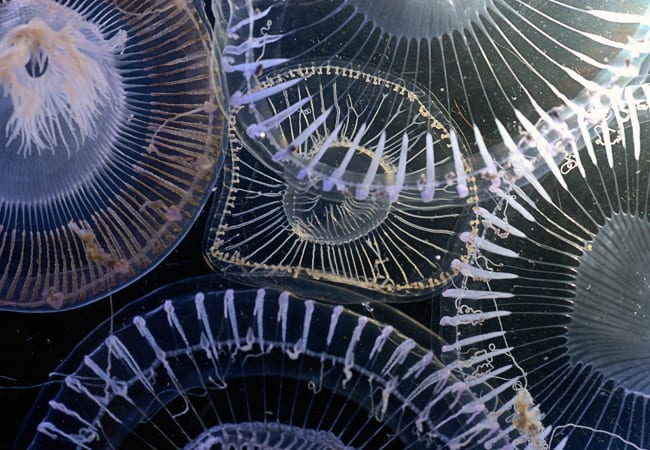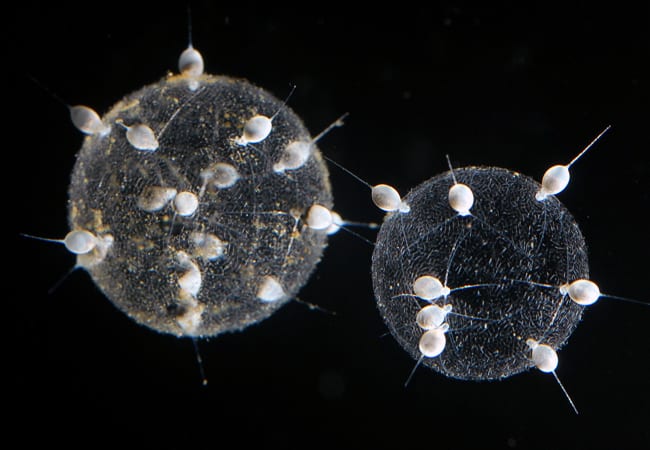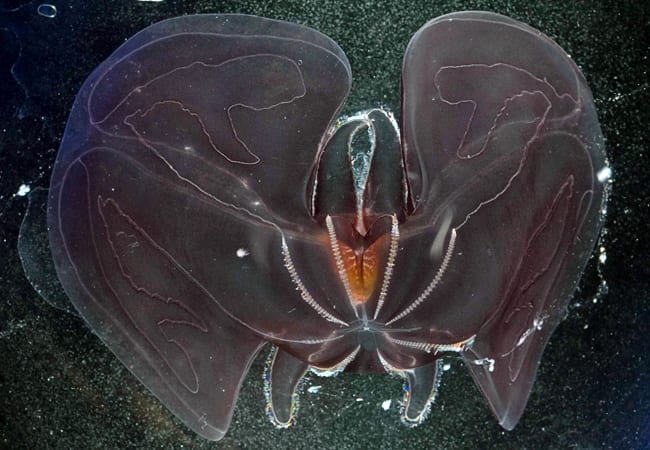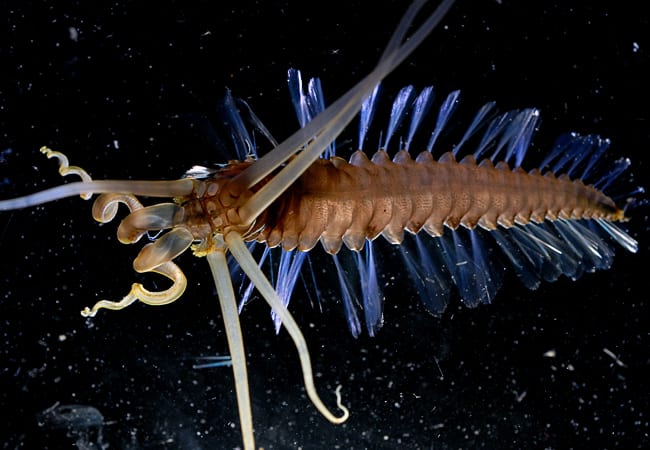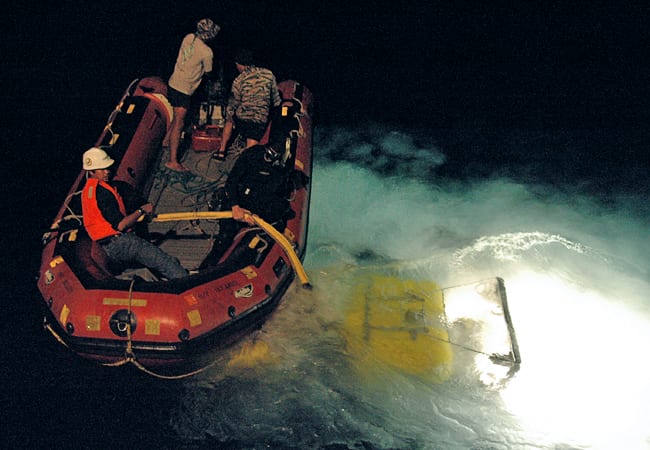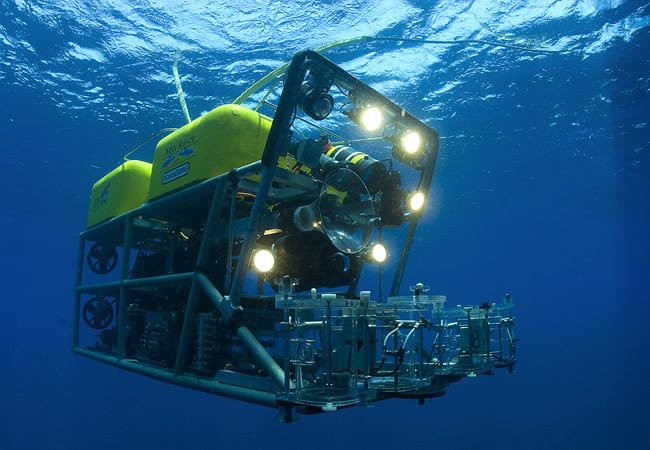Creatures of the Celebese Sea
- Scientists of the “Inner Space Speciation Project”—an expedition to look for new species in Southeast Asia’s Celebes Sea—used a wide range of methods to sample ocean life. Different tools and techniques work best to sample different kinds and sizes of organisms. Their tools and techniques ranged from simple and low-tech-scuba divers using jars to capture delicate creatures—to sophisticated tools that use laser light to visualize small animals. (Photo by Michael Aw)
- Lying just north of the equator, the Celebes Sea is the center of the most biologically diverse area of the world’s ocean. The Inner Space Speciation Project expedition began in the port of Manila (top center) and went south through the Sulu Sea to a study site southeast of the Sulu Archipelago, where the ocean bottom falls off abruptly to the seafloor thousands of meters below. (Image courtesy of Kerry Lagueux, New England Aquarium)
- WHOI biologist Larry Madin carries a dark red jellyfish to the ship’s laboratory refrigerator, during a cruise in October 2007 to study life in the cold deep water of the Celebes Sea. When deep-sea animals collected with the ROV were brought to the tropical surface, they went directly into a cold environment. Madin was one of several specialists on gelatinous animals (such as jellyfish) who participated in the cruise, along with Madin’s graduate school adviser William Hamner. (Photo by Emory Kristof, National Geographic Society)
- Research cruises in remote oceans can take years of planning and assistance from people who know the area. Caron De Mars, the environment, science, technology, and energy officer at the U.S. Embassy in Manila, aided the Celebes Sea expedition team in getting all the necessary clearances and permits from the Philippines government, making contacts with scientists there, and setting up school visits and programs. “Not only that,” said expedition co-leader Larry Madin, “she was an enthusiastic diver and a great addition to the cruise. (Photo by Emory Kristof, National Geographic Society)
- The Video Plankton Recorder (VPR) is an imaging system towed behind the ship that captures video images of very small plankton. On this expedition, Cabell Davis, WHOI biologist and director of the WHOI Ocean Life Institute, tested a new holographic instrument that uses laser light to create digital holograms of plankton. (Photo by Emory Kristof, National Geographic Society)
- Scientists from the Philippines who participated in the expedition were photographed on board the ship. In the front row, L to R are: Valeriano Borja, National Fisheries Research and Development Institute (NFRDI), Philippines; and Joseph Rayos, NFRDI, Philippines. In the back row, L to R, Mely Romero, Director of Research, and Filemon G. Romero, Professor, both at Mindanao State University Tawi-Tawi College of Technology and Oceanography; Noe B. Gapas, Curator of Phycology, National Museum of the Philippines; and Hildie Maria Nacorda, Research/ Technical Assistant, Marine Science Institute, University of the Philippines. Not pictured: Rogelio C. (Boy) Rivera, National Museum of the Philippines; Adonis S. Floren, Silliman University – Angelo King Center for Research and Management (SUAKREM) (Photo by Boy Rivera, National Museum of the Philippines)
- As the Celebes Sea expedition team watched the video feed from their ROV of the seafloor very deep and very far from shore, they were unpleasantly surprised. At 2,800 meters (1.74 miles) deep, the vehicle came upon an unnatural hill of human-made trash and garbage that had collected there from above, presumably due to currents and the steep slope.
- Halfway through the Celebes Sea expedition, the ship stopped near a nearby island to take on provisions. Local officials, university faculty, the diving club, and a cultural troupe of dancers and musicians came out to the ship, where U.S. and Filipino scientists spoke about the cruise and the area’s biodiversity, and dancers and musicians performed amid winches and cranes on the crowded deck.
- Scientists captured this pink, transparent sea cucumber, an animal related to sea stars and sea urchins, about 2,500 meters (1.55 miles) deep in the Celebes Sea. It consumes food on the seafloor, then uses the wing-like collar around the front of its body to “fly” off the bottom up into the water. This one has had a recent meal, as seen in its full gut. (Photo by Larry Madin, Woods Hole Oceanographic Institution)
- The deep ocean is a dark environment where the only light come from bioluminescent animals, those that produce light that may help them find mates or lure food. But what if a transparent animal eats a luminescent animal that then flashes in the predator’s stomach? Would that advertise its whereabouts to larger hungry animals? Scientists believe that many deep-sea animals, like this jellyfish, have red pigment around their stomachs to keep their prey’s light from escaping. (Photo by Larry Madin, Woods Hole Oceanographic Institution)
- Looking like a collection of bubbles, this pyrosome (the name means “fire body”) is a cylindrical colony, 7 centimeters (2.75 inch) long, made up of individual animals (the “bubbles”.) Each tiny individual animal pumps water through its body, filtering out food and propelling the brightly luminescent colony forward. (Photo by Larry Madin, Woods Hole Oceanographic Institution)
- Expedition scientists collected this 3-centimeter (1.25-inch) isopod, a relative of land-based pill bugs, 2,000 meters (1.25 miles) deep in the Celebes Sea, using a collection chamber mounted on a remotely operated vehicle. It uses its very long legs to “crawl” through the water. (Photo by Larry Madin, Woods Hole Oceanographic Institution)
- Most jellyfish are so fragile that they are destroyed when collected with a plankton net. Scuba divers carried collecting bags filled with glass jars to collect delicate animals near the surface, such as these Aequorea jellyfish. (Photo by Larry Madin, Woods Hole Oceanographic Institution)
- They look like space stations, but actually are colonial forms of single-celled organisms called radiolarians, collected in the deep Celebes Sea. The white blobs are individual cells, and the geodesic dome-like structure is the architectural structure of the colony. Radiolarians make such structures out of glass-like slivers of silica. (Photo by Larry Madin, Woods Hole Oceanographic Institution)
- With the ROV, scientists found this 15-centimeter (6-inch) ctenophore, a diaphanous relative of jellyfish, drifting just above the bottom of the Celebes Sea, about 2,500 meters (1.55 miles) deep. Ctenophores living near the surface are transparent, but this rare, undescribed, deep species is almost entirely black. (Photo by Emory Kristof, National Geographic Society)
- When the marine biologists on the Celebes Sea expedition discovered this extraordinary worm they knew they had something different. They soon gave it a temporary name: “Squidworm,” because of its squid-like tentacles. It turned out to be a species new to science. (Photo by Larry Madin, Woods Hole Oceanographic Institution)
- After a nighttime descent to deep water of the Celebes Sea to take video and samples, the MaxRover ROV, which normally came up alongside the ship, needed an assist to get back on board. The ROV crew scrambled to set out from the research ship in an inflatable boat in the dark of night, but soon floated over brilliant lights from the ROV below. (Photo by Larry Madin, Woods Hole Oceanographic Institution)
- Scientists searching for new species in the Celebes Sea employed a wide range of equipment, including the remotely operated vehicle (ROV) called “MaxRover Global Explorer” to depths of 3,000 meters (1.86 miles) to survey life in the deep water and near the ocean floor. Descending through the blue Celebes Sea, the ROV, owned by Oceaneering International, Inc., was equipped with a high-definition video camera and collecting chambers in which creatures in the water could be captured. (Photo by Michael Aw)
TOPICS: Jellyfish & Other Zooplankton
Image and Visual Licensing
WHOI copyright digital assets (stills and video) contained on this website can be licensed for non-commercial use upon request and approval. Please contact WHOI Digital Assets at images@whoi.edu or (508) 289-2647.

